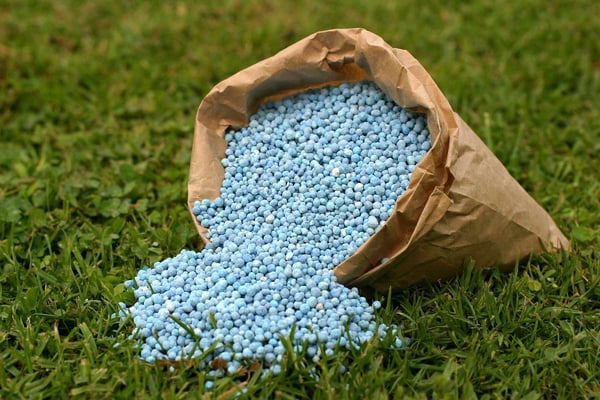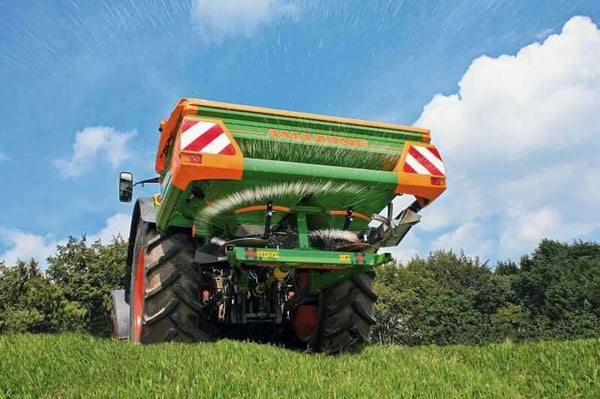Slow-release vs. Quick-release Fertilizer: Which One is Best for Your Lawn?
If there’s one thing about lawn care that can be confusing, fertilization is it.
Experts always recommend you read the label first — but these labels seem to be written for chemists.
The first thing you’ll notice is the bags have varying ranges of three sets of numbers emblazoned on them.
These numbers represent Nitrogen (N), Phosphorus (P) and Potassium (K) in that order, and using the right blend of N-P-K for your lawn takes an understanding the specific needs of your turf and soil.
But how much of each does your lawn need?
The second thing is lawn fertilizers come in liquid or granular form, which means you can spray them or spread the pellets across your lawn.
So which type of fertilizer do you need and when should you use it?
 Finally — as if you didn’t have enough to think about already — fertilizers come in slow-release and quick-release formulations.
Finally — as if you didn’t have enough to think about already — fertilizers come in slow-release and quick-release formulations.
Each of these products has its specific benefits and uses based on a variety of factors impacting your lawn.
Let’s take a look at quick-release versus slow-release fertilizers and talk about which one makes the most sense for your lawn.
Fast Facts On Quick-Release Fertilizer
First, it’s important to point out that quick-release and slow-release refer mostly to the nitrogen in the fertilizer.
Quick-release fertilizer does exactly what it says it will do: quickly releases the nitrogen and other nutrients to the turf.
This type of fertilizer is typically more water-soluble, making it dissolve faster in the soil. You should start to see some lawn growth almost immediately with quick-release fertilizer.
There are times when quick-release fertilizer comes in handy.
For instance, if you just planted a lawn and need that quick green up and want to push top growth to help block weeds from growing in, that’s an excellent time for quick-release fertilizer. Newly hydroseeded lawns can benefit from quick-release fertilizer in the beginning stages of growth as well.
Once your lawn is established, however, using quick-release fertilizer can force too much growth too fast. This overabundance of nitrogen can stimulate rapid shoot growth while slowing down root growth and increasing the need for more frequent mowing, which can result in less stress tolerance and slower recovery from any injury to the turf.
Too much nitrogen can also result in thinner leaf tissue, which increases moisture loss and creates a greater need for water.
Pros of quick-release fertilizer: Instant green up and growth of turf and great for pushing growth on new lawns.
Cons of quick-release fertilizer: On established lawns, too much quick-release fertilizer can force too much growth too quickly, meaning more mowing or the need to cut too much of the plant at once. (As a rule of thumb for mowing healthy, thriving turf, we usually don’t like to cut below one-third of the grass blade.)
Slow And Steady With Slow-Release Fertilizer
Slow-release fertilizer releases all of its nutrients over time, so that nitrogen is always available. This type of fertilizer is water insoluble, meaning it dissolves more slowly.
The benefits of slow-release fertilizer are many. First, you don’t have to fertilize your lawn as often. You can also distribute fertilizer more evenly with slow-release formulas, especially if you’re using granular versus liquid. You’re also less likely to lose fertilizer from rain since the lawn retains those nutrients over a longer period of time.
 While it works more slowly, slow-release fertilizer is ideal for established lawns to keep them lush and thick, yet prevent huge spikes in growth.
While it works more slowly, slow-release fertilizer is ideal for established lawns to keep them lush and thick, yet prevent huge spikes in growth.
Pros of slow-release fertilizer: Slow-release means nutrients are released more uniformly across the lawn in a slow, steady fashion. This provides even, paced growth and cuts down on the amount of fertilizer needed over a growing season.
Cons of slow-release fertilizer: You won’t see an instant green up.
In The End, Fertilizer Blends Are Best
Blends of slow-release and quick-release fertilizers are used on lawns to provide the best of both types, since they deliver both immediate and long-term results.
For instance, in the summer we’ll use 25 percent quick-release and 75 percent slow-release fertilizer to provide some instant green on established lawns but avoid large spikes in growth so mowing heights remain stable.
But for a new lawn, we might use 50 percent or 60 percent quick-release to help the lawn along in its establishment and 40 percent slow-release so the plants continue to receive nutrients over time.
Most of the time, we’ll use these products in a granular—or pellet—form. And during a full, five-step fertilization program, there is no difference in cost whether we use more quick-release or slow-release fertilizer on your property.
Our program is based on your specific lawn’s needs. The real key is fertilization consistency to prevent weeds and keep the lawn thriving.
Pros of fertilizer blends: The right blend can give each lawn exactly the mix of quick-release and slow-release fertilization it needs.
Cons of fertilizer blends: Not knowing which blend is right for your lawn.
Quick-release, Slow-release, Blends, Oh My!
Fertilization can be complicated. Knowing what your turf needs at its specific stage of growth is our job. Lawn Buddies can make your lawn the star of the neighborhood with a customized, six-step fertilization program for your Idaho Falls, or Boise, ID lawn.
Getting started is easy:
- Fill out the form on this page
- Call us at (208) 656-9131
- Or read more about our services

Image Source: Granular Spreader



